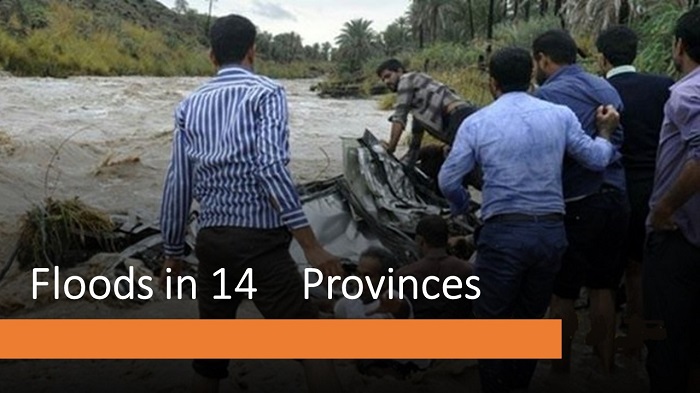
Floods devastate fourteen provinces in Iran.
Heavy floods ravaged the city of Qom, Central Iran on Monday, one day after floods in Razavi Khorasan damaged every city in the northeastern province. The Qom floods washed away vehicles and filled stores and factories with muddy water, further devastating a city that has already been dealt a brutal blow by the coronavirus.
Qom was the first known epicenter of the coronavirus outbreak in Iran, and 2,700 people have died from the virus in Qom Province alone, according to the latest report from the MEK Iran.
Razavi Khorasan Province
In Razavi Khorasan Province, floodwaters blocked four major roads between cities and 14 smaller roads between villages. Every city sustained damage, but Davarzan, Sabzevar, Javin, and Joghtay were the hardest hit. Many people in villages near Davarzan were forced to evacuate their homes to escape rising floodwaters. Two deaths were reported in the cities of Rashtkhar and Khaf, and another person has been reported missing.
Following floods in Razavi Khorasan Province in northeast Iran on Sunday, water levels have been rising and floods are now engulfing the city of Qom in central Iran, known as one of Iran’s coronavirus hotspots.#Iran#COVID19 https://t.co/ltJvFyyuU5
— People's Mojahedin Organization of Iran (PMOI/MEK) (@Mojahedineng) April 13, 2020
“Due to strong floods in the village of Zardab Balakhaf, a 31-year old man and a 13-year old child were washed away. There is no sign of them. A 27-year old man being washed away was saved by local villagers and was later sent to a hospital,” said a local resident.
Qazvin Province
Floods hit the northwestern Qazvin Province on Saturday, damaging Takestan and the surrounding villages, including Asfarvarin, Dowlatabad, Kahak, Yahya-abad, Ali Khamenei, Saj, Rakan, and Lazjerd. Boin Zahra’s famous Sagesabad bridge was destroyed in the flood, making it the most recent addition to the list of bridges and landmarks that have been neglected by regime officials and left vulnerable to floods and other disasters.
Incompetence and Corruption
More floods are forecast over the next week, with as many as 20 provinces affected. Past floods have been catastrophic, and each successive flood becomes more devastating due to the regime’s failure to take action to repair critical infrastructure. Iran’s roads, bridges, and dams are crumbling. IRGC-controlled companies are given contracts to build or repair these structures, and they cut costs and pocket the profits. The results are often deadly. This is the third year in a row that Iran has witnessed the result of shoddy roads, crumbling dams, and rotting bridges.
The amount of rain in parts of #Iran recently has been so heavy that it has caused massive local #flooding.https://t.co/lsMAItj41l #MEK #Iran #Flood @USAdarFarsi pic.twitter.com/v9wE35DXOw
— MEK Iran (Mujahedin-e Khalq) (@MEK_Iran) April 9, 2020
In the aftermath of floods, the regime fails to act quickly to provide assistance to those who are displaced. Flood victims have been left clinging to trees, waiting on rooftops, or stranded on mountaintops for days while regime authorities made excuses for why they could not help. It is more dangerous now than ever for anyone to be unsheltered. Assistance needs to reach the people who need it.
In times of crisis, people need to know they can depend on their leaders. They need to believe they are cared for, and they need to believe their leaders are competent to steer them out of harm’s way. The Iranian people are facing the coronavirus and severe flooding, and they do not have leaders they can believe in. This is their biggest crisis.
